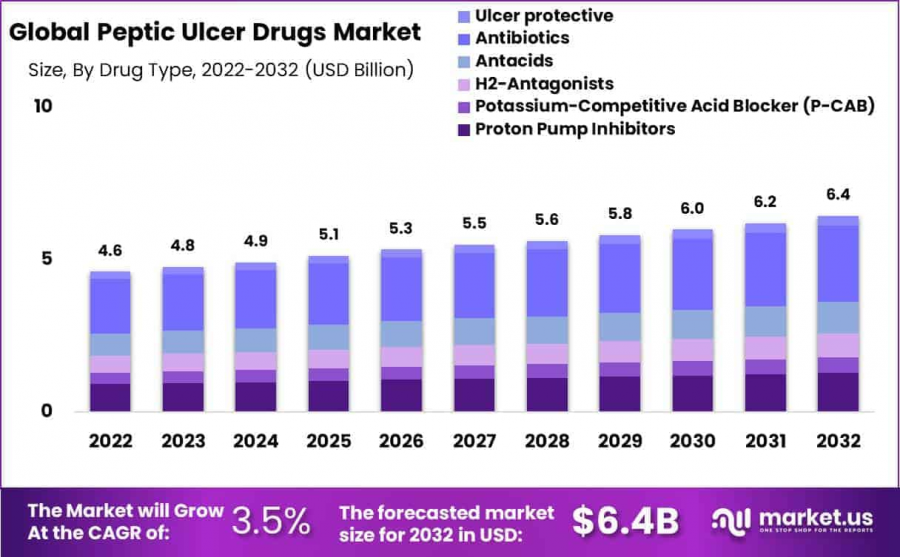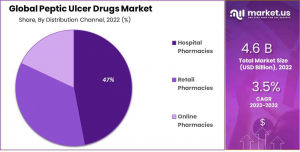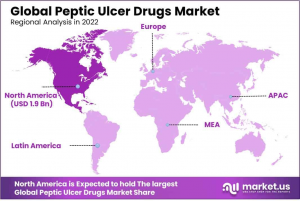
Peptic Ulcer Drugs Market to Reach USD 6.4 Billion by 2032, Growing at a 3.5% CAGR
Global Peptic Ulcer Drugs Market size is expected to be worth around USD 6.4 Billion by 2032 from USD 4.8 Billion in 2023, growing at a CAGR of 3.5%
NEW YORK, NY, INDIA, February 3, 2025 /EINPresswire.com/ -- Report Overview
The Global Peptic Ulcer Drugs Market size is expected to be worth around USD 6.4 Billion by 2032 from USD 4.8 Billion in 2023, growing at a CAGR of 3.5% during the forecast period from 2023 to 2032.
Peptic ulcer drugs are essential in the treatment of peptic ulcers, which are sores that develop on the lining of the stomach, small intestine, or esophagus due to the erosion caused by stomach acid. These ulcers can lead to significant discomfort, pain, and, in severe cases, complications such as bleeding or perforation. Peptic ulcer drugs work by reducing stomach acid production, protecting the lining of the stomach, or eradicating Helicobacter pylori, a bacterium commonly responsible for causing the ulcers.
Common treatments include proton pump inhibitors (PPIs), H2-receptor antagonists, antacids, and antibiotics for H. pylori infection. These medications help relieve symptoms, promote healing, and prevent recurrence of ulcers.
The growing prevalence of conditions like H. pylori infection and excessive use of nonsteroidal anti-inflammatory drugs (NSAIDs) has increased the demand for effective peptic ulcer treatments. As a result, pharmaceutical companies continue to innovate, developing new formulations and combination therapies to improve patient outcomes and enhance quality of life.
This annual report offers a comprehensive analysis of the global Peptic Ulcer Drugs market, providing valuable insights into future developments. By evaluating the historical and current dynamics of the Peptic Ulcer Drugs industry, the report includes a detailed forecast to inform key stakeholders. The Peptic Ulcer Drugs market report is designed to assist businesses in identifying and capitalizing on opportunities, while understanding key drivers, restraints, risks, and emerging trends. It also explores how time-sensitive factors impact the market under varying assumptions.
This report provides precise data, empowering clients to make informed decisions. The latest market innovations and developments are tracked to help businesses navigate obstacles and seize growth opportunities. In the coming years, the Peptic Ulcer Drugs market is poised for rapid growth. As companies increasingly seek innovative, cost-effective, lightweight, and sustainable packaging solutions, the global Peptic Ulcer Drugs market is expected to witness a substantial growth trajectory.
Unlock Competitive Advantages With Our PDF Sample Report https://market.us/report/peptic-ulcer-drugs-market/request-sample/
Key Takeaways
1. Peptic Ulcer Overview: Peptic ulcers are painful sores that develop on the mucosal lining of the stomach, small intestine, or esophagus, often causing symptoms like abdominal pain, heartburn, and, in severe cases, bleeding.
2. Etiology and Risk Factors for Peptic Ulcers: Peptic ulcers can be triggered by factors such as Helicobacter pylori infection, prolonged use of nonsteroidal anti-inflammatory drugs (NSAIDs), heavy smoking, excessive alcohol consumption, and stress.
3. Drug Classes: Common treatments for peptic ulcers include proton pump inhibitors (PPIs), H2-receptor antagonists, antacids, antibiotics (for H. pylori eradication), and cytoprotective agents, all aimed at reducing symptoms and promoting healing.
4. Proton Pump Inhibitors (PPIs): PPIs are widely prescribed to reduce stomach acid production, offering symptom relief and accelerating the healing process of peptic ulcers.
5. H2-Receptor Antagonists: H2-blockers decrease stomach acid production, helping alleviate symptoms and support ulcer healing.
6. Antacids: Antacids neutralize stomach acid, providing temporary relief from the pain associated with peptic ulcers.
Scope of the Report:
The global Peptic Ulcer Drugsindustry report provides insights into production, consumption, and revenue data across various regions. This research report offers a comprehensive market evaluation, covering future trends, growth drivers, key insights, and verified industry data. It also highlights market share and growth rates across major regions.
Key market players and manufacturers are included in the report, offering a detailed analysis of industry trends and strategic developments. The findings enhance market understanding, enabling informed decisions related to geographical expansion, capacity growth, and new opportunities. The primary market drivers focus on global business expansion. Additionally, the report presents trends, advancements, material insights, technological developments, and the evolving market structure.
Key Highlights of the Peptic Ulcer Drugs Market Study
The insights presented in this report offer critical statistical data and key figures, enabling stakeholders to evaluate market trends, strategize effectively, and enhance their competitive ranking. Researchers have conducted a thorough Strengths, Weaknesses, Opportunities, Threats (SWOT) analysis, along with identifying major challenges to provide a comprehensive market assessment. Additionally, experts have utilized PESTEL analysis and Porter’s Five Forces framework to examine external market influences. By combining quantitative and qualitative research approaches, this study provides a deeper understanding of the Peptic Ulcer Drugs market, helping businesses establish a strong market presence.
Market Segments:
Based on Drug Type
•Proton Pump Inhibitors
•Potassium-Competitive Acid Blocker (P-CAB)
•H2-Antagonists
•Antacids
•Antibiotics
•Ulcer protective
Based on Indication
•Duodenal Ulcer
•Gastric Ulcer
•GERD (Gastroesophageal Reflux Disease)
•Gastritis
•Other Indications
Based on Distribution Channel
•Retail Pharmacies
•Hospital Pharmacies
•Online Pharmacies
Buy This Premium Research Report@ https://market.us/purchase-report/?report_id=100148
Market Dynamics
Driver: The increasing global prevalence of peptic ulcer disease (PUD) significantly drives the demand for effective treatments. Factors such as Helicobacter pylori infection and the widespread use of nonsteroidal anti-inflammatory drugs (NSAIDs) contribute to the high incidence of PUD. According to the National Institutes of Health (NIH), approximately 4 million people in the United States are affected by peptic ulcers annually. This high prevalence underscores the critical need for effective pharmaceutical interventions to manage and treat PUD, thereby propelling market growth.
Trend: A notable trend in the treatment of peptic ulcers is the increasing use of combination therapies. These regimens often include proton pump inhibitors (PPIs) alongside antibiotics to eradicate H. pylori infection. The NIH recommends a 14-day course of triple therapy, combining a PPI with clarithromycin and amoxicillin, as the standard treatment for H. pylori-associated ulcers. This approach enhances treatment efficacy and reduces the risk of antibiotic resistance, reflecting a shift towards more comprehensive and effective therapeutic strategies.
Restraint: Antibiotic resistance poses a significant challenge in the treatment of peptic ulcers, particularly those caused by H. pylori infection. The Centers for Disease Control and Prevention (CDC) reports that antibiotic resistance in H. pylori has led to decreased eradication rates, complicating treatment protocols. This resistance necessitates the development of new antibiotics and alternative therapies, highlighting the need for ongoing research and innovation in the pharmaceutical industry to address this growing concern.
Opportunity: The evolving landscape of peptic ulcer treatment presents opportunities for the development of novel therapeutics. Innovations such as transdermal drug delivery systems and biologic therapies offer potential alternatives to traditional oral medications. Research published in the National Institutes of Health (NIH) highlights the promise of transdermal delivery methods in enhancing drug absorption and patient compliance. Exploring these alternative delivery systems and biologic agents could lead to more effective and patient-friendly treatments, addressing current limitations and improving therapeutic outcomes.
Key Objectives Of The Peptic Ulcer Drugs Global Market:
• To analyze the global Peptic Ulcer Drugs market consumption, industry size estimation, and forecast.
• To understand the general trends of the global Peptic Ulcer Drugs market by understanding its segments and sub-segments.
• Focuses on the leading manufacturers of the Global Peptic Ulcer Drugs market to analyze, describe and develop the company's share, revenue, market value, and competitive landscape of the company over the years.
• To analyze the Peptic Ulcer Drugs market in terms of upcoming prospects, various growth trends, and their contribution to the international market.
• To analyze the production/consumption analysis of the global Peptic Ulcer Drugs market with respect to key regions.
• To get detailed statistics about the key factors governing the growth potential of the global Peptic Ulcer Drugs market.
Key Market Players:
•Abbott
•AstraZeneca plc
•Zydus Lifesciences Limited
•Boehringer Ingelheim International GmbH
•Novitium Pharma
•Yuhan Corporation
•Pfizer Inc.
•Pharmaking Co. Ltd.
•Viatris Inc.
•RedHill Biopharma Ltd.
•Novartis AG
•Other Key Players
Regional Analysis:
• North America (Panama, Mexico, Barbados, United States, Canada, Puerto Rico, Trinidad, and Tobago, etc).
• South and Central America (Brazil, Chile, Argentina, Belize, Costa Rica, Panama, Guatemala, El Salvador).
• Europe (Spain, Belgium, France, Holland, Germany, Sweden, Switzerland, San Marino, Ireland, Norway, Luxembourg, etc).
• Asia-Pacific (Qatar, China, India, Hong Kong, Korea, Israel, Australia, Singapore, Japan, Kuwait, Brunei, etc.).
• The Middle East and Africa (United Arab Emirates, Egypt, Algeria, Nigeria, South Africa, Angola, Saudi Arabia, Bahrain, Oman, Turkey, Lebanon, etc.).
Key questions answered in the report include:
• What are the key factors driving the Peptic Ulcer Drugs market?
• What was the size of the Emerging Peptic Ulcer Drugs Market in 2024?
• What will be the size of the Emerging Peptic Ulcer Drugs Market in 2033?
• Which region is projected to hold the highest market share in the Peptic Ulcer Drugs market?
• What is the market size and forecast of the global Peptic Ulcer Drugs market?
• What products/segments/applications/areas will be invested in the Global Peptic Ulcer Drugss Market during the forecast period?
• What are the technological trends and regulatory framework of the Global Peptic Ulcer Drugs market?
• What is the market share of the key vendors in the global Peptic Ulcer Drugs market?
• What are the right modes and strategic moves to enter the Global Peptic Ulcer Drugs Market?
Reasons to Acquire This Report
- Provides a comprehensive industry outlook, covering global market trends and high-growth segments.
- Includes market share analysis of leading players, company profiles, and critical industry insights.
- Identifies emerging trends, high-growth regions, and market drivers, restraints, and opportunities.
- Examines the latest technological advancements and innovations across various industries.
- Estimates current market size and future growth potential across key applications and industries.
Lawrence John
Prudour
+ +91 91308 55334
email us here
Distribution channels:
Legal Disclaimer:
EIN Presswire provides this news content "as is" without warranty of any kind. We do not accept any responsibility or liability for the accuracy, content, images, videos, licenses, completeness, legality, or reliability of the information contained in this article. If you have any complaints or copyright issues related to this article, kindly contact the author above.
Submit your press release


